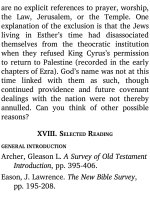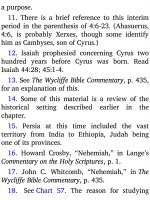Jensens survey of the old testament adam 155
Bạn đang xem bản rút gọn của tài liệu. Xem và tải ngay bản đầy đủ của tài liệu tại đây (117.6 KB, 4 trang )
speeches of Elihu are recorded in 32:1—
37:24.
C. SURVEY CHART
Chart 67 is a survey chart of Job, showing
the book’s organization by various outlines.
Refer to this chart as you make the
following observations and complete the
study suggestions:
1. Note how the book opens (“Job Before
the Trial”), and how it closes (“Job After the
Trial”). Read the passages involved.
2. Observe the three-part outline of style
at the top of the chart.
3. Study the outlines shown below the
base line. Check out these outlines with the
results of your own survey study. You may
need to scan the biblical text at some places
to verify an outline. Justify the location of
main divisions at 38:1; 40:3; and 42:7.
4. What is the basis for dividing the
controversies of chapters 4-31 into three
cycles? (Refer back to your work sheet,
showing the alternations of speakers in the
dialogues.)
5. Observe the progression at the bottom
of the chart, beginning with “The Problem
of Pain.”
6. Read these other choice passages of Job
at this time: 1:21; 5:17; 14:14; 16:21; 19:2327; 26:7-14; 28:12-28; 42:1-6.
7. You may wonder why such a large
portion of the book is devoted to the wrong
diagnoses and arguments of Job’s three
friends. If their main charge was that Job’s
su ering was caused by his personal sins, do
you suppose their own security was
imperiled by the possibility of the same kind
of su ering befalling them? If so, does this
partly explain their persistence in dealing
with Job?
IV. PROMINENT SUBJECTS
Of the many important subjects of the
book of Job, three are especially prominent:
Satan, the problem of pain, and genuine
trust.
A. SATAN
Much can be learned about Satan from the
book of Job. For example, Satan is not a
name representing impersonal evil; Satan is
the personal enemy of God and His children.
The persons and events of the narrative of
Job are real persons and actual events.
“There was a man…. There was a day….
Then Satan … smote Job” (1:1, 6; 2:7). This
is precise, genuine history. And, lest one
think that Satan is no longer active in
accusing the children of God, the last book
of the Bible reveals the sober truth of
Satan’s continuing work until end times:
“The accuser of our brethren has been
thrown down, who accuses them before our
God day and night” (Rev 12:10; cf. 1 Pet
5:8).
Satan rst appears in the story of man in
the Garden of Eden. Recall the account of
his beguiling Adam and Eve (Gen 3:1-7).
The text refers to him as “the serpent.” How
do you know that this was Satan? (Cf. Rev
12:9.) Why is Satan antihumankind? Note
that
the
name Satan literally means
“adversary.” Of its nineteen appearances in
the Old Testament, fourteen are in Job. The
name devil means “slanderer,” and is found
only in the New Testament (sixty times).
B. THE PROBLEM OF PAIN
The book of Job is the Bible’s fullest
treatment of this vexing problem. The
summary given below shows how the book









